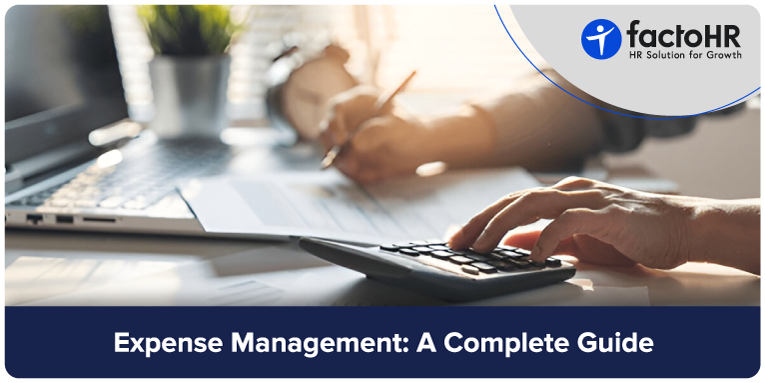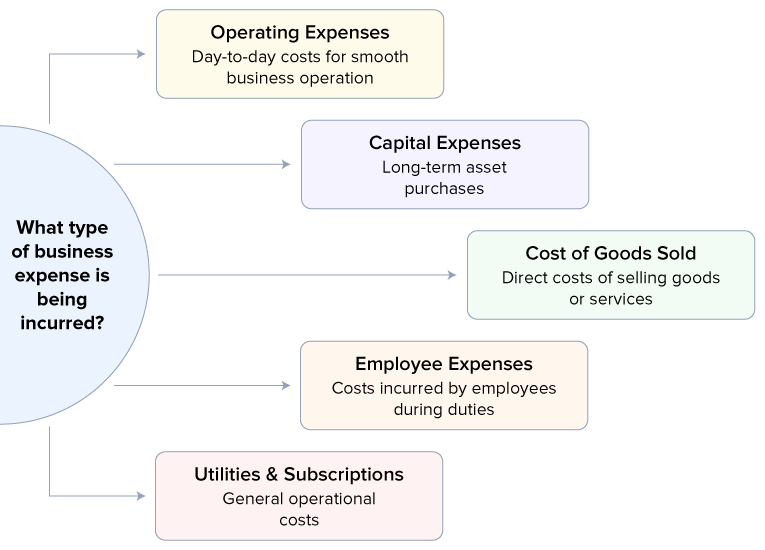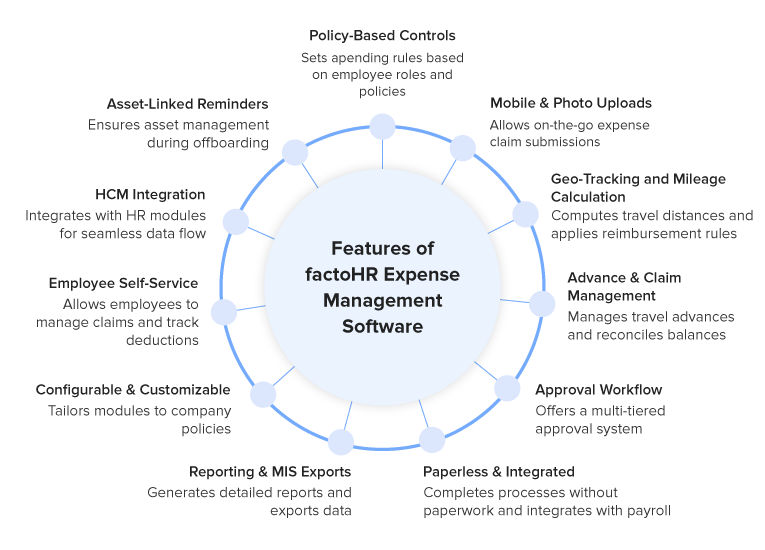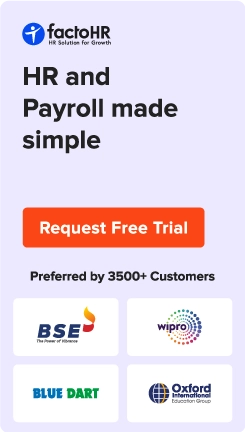What is Expense Management: A Complete Guide

Table of Contents
Effective expense management is essential in any company, and it is paramount in gaining financial discipline and sustainability. Expenses, like employee reimbursement, travel expenses, or payments to vendors, every transaction should be traced, accounted for, and must comply with enterprise policy.
This is where cost management comes in. It is a structured process that helps businesses control spending, ensure compliance, and gain real-time visibility into financial activities. This guide will explore the definition of expense management, how it works, the difference between expense management and spend management, its key objectives, and why it is crucial to business success.

What is Expense Management?
Expense Management refers to how a company monitors, manages, and reviews its expenditures so as to make every expenditure valid, affordable, and in line with the company’s regulations. It focuses on every aspect, like employee-related expenses and reimbursement. To make cost management effective, it should comply with various policies and maintain accurate records.
Expense management includes keeping track of all business-related expenditures, including employee reimbursements, travel expenses, office supplies, and payments to vendors. It helps establish spending constraints and policies to prevent excessive spending or purchases.
It also includes reviewing expense data to identify trends, inefficiencies, and opportunities for cost savings and better financial planning. The table below explains the difference between expense management and spend management.
| Aspect | Expense Management | Spend Management |
|---|---|---|
| Focus | Employee-related and operational expenses | All company spending, including procurement and vendor payments |
| Scope | Narrower, deals mainly with business expenses | Broader, includes sourcing, procurement, and supplier management |
| Tools | Expense tracking apps, reimbursement platforms | Spend analytics platforms, procurement tools |
Key objectives:
- Cost Control: Preventing wasteful or unauthorized spending.
- Compliance: Ensuring compliance with internal regulations and taxes.
- Financial Health: Supporting accurate financial reporting, cash flow management, and profitability.

Why is Expense Management Important?
- Controls Business Spending: It prevents overspending and enforces company financial management policies.
- Ensures Compliance: It assists in addressing tax and regulatory requirements to stay compliant and evade any form of legal or financial charges.
- Supports Budgeting and Forecasting: Accurate expense data aids in financial planning and resource allocation.
- Improves Financial Transparency: It provides clear visibility into where money is being spent.
- Enhances Decision-Making: Informed spending insights help leaders make strategic, data-driven decisions.
What are the Key Components of Expense Management?
The following are the key components of a cloud-based expense management system.
Expense Submission/Entry
Employees submit their expenses on a centralized expense management platform. In this platform, employees submit their receipts digitally through a web portal or mobile application.
Receipt Tracking
Receipts submitted by employees are tracked digitally by the expense management system. It eliminates the risk of losing paper receipts and makes it easier for employers to manage and store them efficiently.
Expense Categorization
The submitted expense receipts need to be categorized to maintain accurate data. Expense management software allows users to select the type of expense, including travel, meals, accommodations, and other costs.
Approval Workflow
This component is a structured process that automates the sequence of steps required for approvals by accelerating the process. It ensures that the expense entries go through the predefined stages. The expense management system identifies the appropriate person for reimbursement approval.
Policy Compliance
Employees must comply with the organization’s drafted policies. HR professionals should set spending limits. Therefore, non-compliant entries are rejected directly. A non-compliant entry can impact the balance sheet and, thus, lead to incorrect tax filings.
Reporting & Analytics
It is one of the essential components of expense management. The reports indicate the spending patterns of employees and outline the spending limit. The expense management software generates reports categorically. It is anticipated that by 2025, expense analytics tools will be utilized by 80% of organizations, allowing them to make informed decisions.
Integration Capabilities
The expense management software is integrated with other systems to operate smoothly. The platforms include accounting, enterprise resources planning (ERP), human resources (HR), and payroll automation systems. Such an integration allows organizations to maintain data consistency and accuracy.
Mobileis Access
Many software providers give mobile accessibility to their clients for managing expenses. Employees who travel frequently or work in a hybrid environment benefit from the mobile application.
Customization and Scalability
Organizations can customize software to align with their requirements. Expense management evolves with the organization to accommodate large amounts of data and scales to support a larger volume of employees.
Support/Documentation
The expense management system offers excellent user support, with thorough documentation that includes user manuals and frequently asked questions. It makes it possible to easily navigate features such as expense submission and approval procedures. Specialized channels, like email, chat, or ticketing, are also available for customer support.
Security/Data Protection
Data protection and security require the implementation of encryption, application of role-based access controls, and regular audits. The system complies with relevant standards, ensuring financial and personal data is safeguarded. The system is also resistant to multi-factor authentication and data backups.

What are the Types of Business Expenses?
To operate a business, a significant amount of spending is required to run it smoothly. These spending are called expenses. The nature of expenses differs according to the spending patterns. Here is the overview of major expenses incurred during business activities.

Operating Expenses (Opex)
Operating expenses are directly related to the production of goods or services. These are the day-to-day expenses that run the business smoothly. These can also be referred to as recurring expenses, as they occur periodically.
Capital Expenses (Capex)
Capital expenditure, also known as capital expense, is an expense incurred in purchasing assets that benefit the organization in the long term. Assets can be tangible and non-tangible.
Cost of Goods Sold (COGS)
The direct expenses involved in selling goods or services are referred to as Cost of Goods Sold (COGS). From manufacturing to packaging, all costs are included in the Cost of Goods Sold (COGS). The higher the COGS, the lower the gross profit margin.
Employee-Initiated Expenses
These expenses are incurred by employees while performing their duties. It includes travel, food, accommodation, and other costs. It is tracked and audited by the expense management software.
Utilities and Subscriptions
Also called Selling, General, and Administrative (SG&A) expenses. These are general expenses incurred during business operations, like electricity and telephone services. It also includes software subscriptions and training for employees to navigate the software.
Traditional vs. Automated Expense Management
Here is the difference between a traditional and an automated expense management system.
| Aspect | Traditional Expense Management | Automated Expense Management |
|---|---|---|
| Data Entry | Manual entry in spreadsheets or paper forms | Automatic data capture via apps and integrations |
| Time Consumption | Time-consuming and repetitive | Fast and streamlined |
| Accuracy | Prone to human errors | High accuracy with reduced manual input |
| Receipt Handling | Physical storage or scanned copies | Digital uploads and OCR (optical character recognition) |
| Approval Process | Manual routing through emails or paper trails | Automated workflows and real-time approvals |
| Policy Compliance | Difficult to enforce and monitor | Built-in policy enforcement and flagging of violations |
| Visibility & Reporting | Limited insights and delayed reports | Real-time dashboards and advanced analytics |
| Integration with Accounting | Often disconnected, manual syncing is required | Seamless integration with accounting and ERP systems |
| Reimbursement Time | Slower processing and payouts | Faster reimbursements through automation |
| Scalability | Hard to scale with business growth | Easily scalable for teams of any size |

Features of factoHR Expense Management Software

Policy-Based Controls
The software sets spending rules based on employee role, location, travel policies, purpose, and predefined limits. It ensures only policy-compliant claims are submitted and managed.
Mobile & Photo Uploads
It can help submit expense claims on the go via mobile apps—upload receipts and proof instantly for faster processing.
Geo-Tracking & Mileage Calculation
Automatically compute travel distances, detect punch-ins/punch-outs via GPS, and apply reimbursement rules.
Advance & Claim Management
Employees can request travel advances; after expense submission, the tool calculates variances to reconcile remaining balances or due refunds.
Approval Workflow
It offers a multi-tiered approval system with pending approvals and pending payments dashboards, supporting individual and bulk reviews for expense claims.
Paperless & Integrated
Claim submission, approval, and reimbursement can be completed without any paperwork. Integrates with payroll software and HCM for seamless processing.
Reporting & MIS Exports
Generating detailed reports and tracking travel expenses becomes easy. Advanced analysis and payment batches can help gain real-time visibility and export as needed.
Configurable & Customizable
Organizations can tailor all modules, like expense categories, limits, and approval flows. According to company policies, customization is available according to department, branch, or hire level.
Employee Self-Service
Employee self-service portal allows employees to make claims, check the status of their requests, upload documents, and track tax deductions.
HCM Integration
The software is integrated with HR modules like payroll, asset tracking, attendance, and timesheets, ensuring seamless data flow and a unified user experience.
Asset-Linked Reminders
When employees exit or during the offboarding process, ensure that management of these assets is completed before final exit settlement.

What are the Best Practices for Effective Expense Management?
Define Clear Policies
Establishing and communicating well-defined expense policies helps ensure employees understand what is reimbursable and what is not. Employees must be clear about the procedures to follow for processing reimbursements.
Train Employees on Usage
Organizations should provide regular training to employees on how to use the expense management system, ensuring accuracy and compliance with company policies.
Conduct Periodic Audits
Regularly reviewing expense reports to detect fraud, ensuring policy adherence, and maintaining financial accuracy. Audits can detect suspicious patterns and take timely action.
Set Spending Limits
When companies set spending caps, it can help control costs and prevent overspending. The spending caps should be based on employee role or department-specific. It will reduce the company’s overall expenditure.
Use Automation to Reduce Errors.
Using technology to automate workflows and real-time validations can help minimize manual data entry, reduce errors, and streamline the expense approval process.
What are the Common Challenges in Expense Management?
Here are the challenges that every organization faces while managing expenses.
Fraud and Policy Volations
Reimbursement fraud is prevalent in daily business activities. Employees submitting false or inflated receipts breach the company’s policies, which results in an increased financial burden. Employees engage in such unethical practices to gain monetary benefits.
Reimbursement Delays
Reimbursements can be delayed because of manual processes or errors. Delays can frustrate employees as they can cause financial imbalances in their personal lives. Therefore, it lowers the employee satisfaction factor.
Lack of Visibility
Lack of visibility refers to the inability to track and manage expenses. Poor management of expense tracking can have negative consequences on the company’s bottom line.
Unclear Expense Policies
Most organizations do not provide clear guidelines on allowable reimbursements; as a result, employees request reimbursement for all the expenses incurred. This confusion can increase the workload on the HR and finance departments as they need to verify each expense.
Manual Processes & Data Accuracy Issues
Traditional expense management was performed manually, which lacked accuracy and speed. Inaccuracy increases rework time and has an indirect negative impact on the employee retention rate.

How to Choose the Right Expense Management Tool?
All businesses have an expense management tool, but the question is, “Do they have the right expense management tool?” The following is a complete checklist for choosing the right expense management tool.
User Interface
An easy-to-use interface makes it easier to report expenses and reimbursements. The expense management tool must be simple to navigate.
Compliance Check
The right expense management tool will align with local payroll compliance to prevent legal risks and tax violations. Organizations should maintain updated software according to laws and regulations.
Processing Speed
The software should be able to process the functions with speed and accuracy. Organizations with a high frequency of expense claims require a fast processing speed.
Software Integration
Integration with accounting and HRMS software is critical to ensure a smooth transition of expenses between different systems.
Post-Purchase Service
The software provider is required to ensure there is credible customer support to eliminate post-purchase issues.
Market Reviews
Before purchasing expense management software, companies should check online reviews and ratings to select the most suitable software.
Cost-Efficiency
The software should provide value for money. There should be various plans to cater to the unique business requirements.
What are the Benefits of Using an Expense Management System?
Using an expense management system adds value to the table by providing benefits like:
Time and Cost Savings
A smart and advanced expense management system like factoHR cuts business operational time. Moreover, it is a sound investment that has a positive impact on the organization’s long-term financial health.
Accuracy and Compliance
The manual recording of expenses can lead to mistakes and also create additional labor. These mistakes include wrong data entry, all the way to losing the receipts. An expense management software reduces the time lost in rework by enhancing the accuracy of the process. Also, it automatically flags non-compliant records that violate the policy.
Financial Visibility and Control
The software ensures monitoring and review of costs. It provides financial visibility through real-time data tracking. The information is highly concentrated and thus is accessible in different departments and offices. HR professionals have the opportunity to monitor expenditures and conduct analyses of the spending patterns. Through analysis, they can limit expenditure on various expenses.
Improved Employee Experience
A user-friendly interface ensures a seamless reimbursement process for employees. Employees can claim their expenses on the website or mobile app. A user-friendly interface reduces unnecessary navigation on the website or mobile application, making it easier to serve the purpose. Therefore, increasing the employee experience.
Integration with Other Systems
Organizations can integrate expense management software with their accounting systems, ERP systems, and HRMS systems. In addition, it is combined with payment platforms that can help with reimbursement processing. These integrations assist in an easy transfer of data and automate activities to provide a 360-degree perspective on spending patterns.
Mobile Accessibility
Employees can claim their expenses from anywhere as the expense claim feature is available on their smartphones.

Conclusion
Proficiency in cost management is useful for maintaining a company’s budget. It can help maintain adherence and safeguard the economic well-being of every organization. The right expense management tool enables companies to refine their financial decisions by thoroughly controlling their expenses.
In today’s digital-first environment, relying on manual or outdated systems will lead to a competitive disadvantage. It is important to note that having modern tools and best practices is no longer optional—it’s a competitive necessity.
To simplify and automate your expense management process, factoHR’s Expense Management Software offers a complete solution. From payroll policy enforcement and mobile claims to automated approvals and real-time reporting, factoHR helps you take complete control of business spending.
FAQs
How to Calculate Expenses?
To calculate expenses, follow these steps:
- Record every business-related purchase, including receipts, invoices, and subscriptions.
- Group costs into categories such as travel, utilities, supplies, payroll, etc.
- Sum up expenses by category and overall to get total expenditure over a specified period (monthly, quarterly, or annually).
- Expense management software can simplify tracking and calculation.
Why Should You Use an Expense Management System?
An expense management system offers several advantages:
- Saves time by automating tracking, approvals, and reporting.
- Improves accuracy by reducing manual data entry errors.
- Provides insights through analytics and reports for better financial decisions.
- Compliance with internal policies and tax regulations.
- Streamlines reimbursements and integrates with accounting systems.
Can Small Businesses Benefit from Expense Management Systems?
Small businesses can gain multiple benefits from an expense management system. These are:
- Better cash flow control
- Faster reimbursement cycles
- Scalability as the business grows
- More efficient audits and documentation
- Time and cost savings through automation and integration with other financial tools
Grow your business with factoHR today
Focus on the significant decision-making tasks, transfer all your common repetitive HR tasks to factoHR and see the things falling into their place.

© 2025 Copyright factoHR


